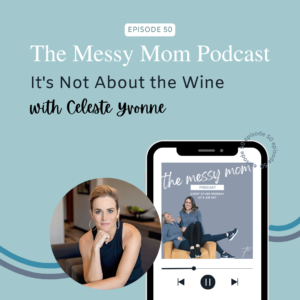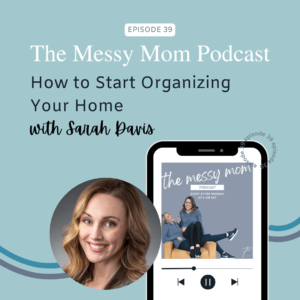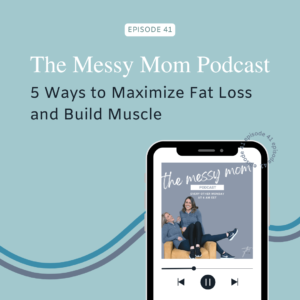We’re back with another podcast episode that in our opinion is both important and a bit messy – today, we’re delving into the world of potty training! Joining us is Liliana Horbatiuk, the founder of Lil Baby Sleep and Potty Training Consulting. Who is also the mom behind Lil Baby Sleep and the Lil Potty Plan. Her mission is to help parents, like yourself, overcome those big milestones that can be really overwhelming and stressful. She helps make the journey smoother and more manageable with support and a plan.
Lily understands the struggles firsthand, as she once found herself in your shoes, juggling potty training her two-year-old while taking care of her newborn. It was messy, scary and she had zero support. This is when she realized the need for straightforward guidance instead of sifting through countless books.
The timing couldn’t be better for Bailey, as Crew, her two-year-old, is showing signs of readiness for potty training. And with another baby on the way in February, the hope is to have Crew potty trained in the next few months (if everything works out as planned).
Continue reading to discover Lily’s valuable advice on when to start potty training, how to prepare, addressing daycare or school scenarios, dealing with potty training regression, and more!
When to Start Potty Training
As Bailey mentioned, it’s about that time for Crew, so we were curious about Lily’s feedback on recognizing when a child is ready for potty training. Since every kid is different, what would she say are some of the signs when it comes to knowing if your child’s ready for potty training and how would she move forward?
Lily points out that with potty training there’s no right time to do it. It’s really when you are ready. However, there are a couple of signs that give you a clue that it’s a good time to start.
First, would be physical signs. Can your child physically pull down their pants or comfortably sit on the toilet? That is going to be important because those skills need to be developed first.
Next is developmental. Can your child follow simple directions? Are they starting to express an interest in going, perhaps by asking to go or showing interest when you go? Are they asking questions? These signs suggest that they’re developmentally grasping the concept that there is a place to go to the bathroom.
Then behaviorally, are they starting to mimic what you’re doing or are they starting to ask?
When looking at all the signs, there are some sweet spot times when it’s good to start. But she always tells parents that it has to be when you are ready because this is a huge skill developmentally. It’s like learning to ride a bike. Parents need to have the time and the patience to help their children through it. Rushing it, even over a weekend, might not be suitable, especially if you have other responsibilities like Lily did of caring for a newborn. And consistency is important, particularly for children of this age.
Another quick question Cari had that tied into this is from Lily’s experience, does she think that the second child can be ready earlier than the first because they have an older sibling helping them out? Lily affirms this possibility, mentioning that competition or imitation can make the process smoother.
Typically, if you start earlier, say between 18 to 22 months, you’re mainly dealing with the learning curve of understanding the sensation and the social skill of where to go. Conversely, if you start on the later side (which is totally okay too), around 3 years old, you might encounter more power struggles as they start to become their own little people and have full control over their bodies. Ultimately, there are pros and cons to starting at any time. Lily suggests that the age range of 22 to 32 months is often a good time, but she would say base it on when is good for your family and when you have the time to do it.
Steps to Start
With Bailey expecting a baby in February and Crew reaching around two and a half by then, her ideal scenario is to have him potty trained beforehand. However, she understands that readiness, both for Crew and herself, is essential. With that being said, Crew is showing signs of interest and readiness. So, if she were to decide to start the potty training process in the next couple of months, what steps should she take to start, and what tips does Lily recommend for implementing this?
First and foremost, Lily points out to start by really understanding what to expect day by day. So for example, preparing the environment with a designated potty and building excitement around the idea of potty training. For instance, creating a countdown that this is happening. Then you also want to communicate with your child about the upcoming change and set clear expectations.
Additionally, there are many potty training methods, but starting with a bare-bottom approach can often be a lot easier. She acknowledges that learning a new skill can be uncomfortable, and while children may initially be excited, that enthusiasm tends to dwindle and go away because learning is hard. So, going bare-bottom allows them to create a learning opportunity and connect the sensation of needing to go with the discomfort when having an accident.
Furthermore, parents need to be mindful of the stress they may inadvertently convey (she is guilty of this as well) to their children. It’s common for parents to feel anxious about accidents and want the process to be quick. However, as we build all this stress up, that stress is felt by our little ones. There’s a lot of pressure. So, Lily recommends not constantly asking if they need to go, as this can again create unnecessary pressure. Instead, to not add stress parents can find subtle ways to prompt without overwhelming or over-prompting when it comes to potty training.
One of the hardest things to do that Lily suggests is to give children space. Parents should gently remind them that the potty is available and then step back, even though it can be difficult. Allowing children to self-initiate and decide when to go empowers them and can speed up the learning process.
Planning for Potty Training
This made Bailey curious if Lilly recommends the weekend approach or if it just depends on the family.
Lily does think it depends on the family. Some families may only have a few days to do it. Sometimes we expect that every child would be able to do it in two to three days, but it is a pretty big skill. Plus, the younger they are, the longer it takes. This means it might take five days or even longer in some cases. So yes, we can plan for as many days as we can depending on what our circumstances are but if you give yourself two days to potty train, you’re going to be so stressed out with that time, that’s just going to delay and make everybody stressed out. So the more time you have, the better. If you can time it for a four-day weekend, during the summer, before the holidays, or during a time when you can plan a couple of extra days, just in case.
Every child is different and learns differently, but she thinks all we can do is prepare ourselves, have a plan, and be consistent. The more prepared and consistent you are, the smoother the potty training journey is likely to be.
Let’s Talk About Poop
Let’s talk about poop for a second. When Cari was potty training her daughter, she was able to get pee down in like two days. But poop, on the other hand, it’s like a whole different thing. So she was curious, if that’s what Lily finds as well and whether that’s a common issue.
Lily says yes, absolutely. She does see a lot of issues with poop when working with families such as withholding. The reason for that is poop is a really weird sensation, especially for kids and it’s a very private thing. If you can imagine pooping in the middle of the living room, it’s an uncomfortable thought. So, you have to keep that in mind that sensation is very scary.
Moreover, if a child is constipated or experiences hard stools, it can be painful and cause anxiety. This anxiety leads to tensing up and clenching, which causes withholding. So it’s really that fear of experiencing pain that holds them from actually doing it.
Lily suggests that the best way to overcome this fear is to face it head-on and go through it together with your child instead of avoiding the issue. Holding and supporting them through the experience can help them realize that it’s not so bad after all.
Additionally, she adds that diapers are a very private experience for children. Diapers provide comfort and allow children not to think about the process of going. Transitioning to using the potty removes that comfort, and children may feel uneasy about it. Also, if your child is seeking privacy or hiding when they need to go, a great solution is offering them choices where they put the potty can be helpful. For some families, creating a designated potty tent or simply giving the child a little space by saying, “Mommy has to get something in the next room,” can provide the privacy they need, making the process more comfortable.
The Role of a Potty Training Specialist
Speaking of poop, this is a good segway into Lily’s specialty as an Oh Crap Potty Training Specialist. We were interested in learning more about what this means and entails.
Lily holds two certifications, one from the Institute of Parenting and Sleep, and the other from the Oh Crap Potty Training program. Oh Crap is a certification program for potty training consultants from the author Jamie Glowacki, who wrote the book “Oh Crap! Potty Training“. Lily is considered both a potty training consultant and an Oh Crap specialist due to her extensive knowledge of this strategy and method. Additionally, she holds a general certification in potty training, equipping her with an understanding of what to expect, when to do things, and how to troubleshoot. This allows her to work with families as a team to navigate the potty training process. It’s the best of both worlds.
While it’s possible for parents to figure out potty training on their own, it can be easier when there’s a method to the madness. Potty training involves various stages and can benefit from a structured approach. Although some might feel pressure to instinctively know what to do as parents, there are numerous resources and support available to help understand what works best for your family and choose what feels right for you.
Tips for Daycare/School
This brings us to Bailey’s next question because Crew is beginning to attend a nursery preschool program for two days a week. She’s curious about tips for potty training when a child is also attending daycare or school. Should you communicate with the teacher and tell them what you’re doing?
Lily finds that when it comes to school/daycare, communication is going to be key because every place does things differently. If the daycare or school is willing to work with you, that’s amazing. You can maintain consistency with your potty training approach at home while understanding that what happens at daycare or school may differ. So, if they’re willing to help you, then communication is going to be important.
But your little one should know where the bathrooms are. For example, you can take them before drop off to get them familiar with where they are located. Additionally, also communicate with the teacher. They do usually have timed potty breaks due to the number of children they care for, which might differ from the self-initiation approach you use at home. It’s important to be flexible and considerate of their circumstances while still maintaining a level of consistency.
Another thing Lily suggests is adding a couple more reminders or finding one teacher that they can identify as the go-to with a simple cue word or keyword like pee, making it as simple as possible.
Ultimately, you will do your thing at home and have the daycare do their thing, hopefully with that communication so that they are following the plan, if possible.
Dealing with Potty Training Regression
Now, some of Bailey’s friends have mentioned potty training regression. It seems like their children achieve potty training success, but then a new baby arrives or significant changes occur, leading to setbacks. What’s Lily’s recommendation for addressing this situation?
Lily explains that every child reacts differently to change; some are more sensitive to it, while others can manage it a bit easier. If significant family changes or disruptions are happening, it’s not uncommon for children to experience potty training regressions, leading to accidents.
The key to regressions is being consistent. While this is temporary, children need a sense of security and consistency during this time. There’s a big change, there’s less consistency, and that happens in life. Therefore, it’s important to help them through that and stay consistent in your potty training routine.
Lily suggests for mothers who are potty training for the second time or have a new baby on the way, it might be best to wait until the baby is around four months old and the major changes have settled before reinitiating potty training. However, if you were already in the process of potty training, it’s perfectly fine to continue; just be sure to maintain your consistency and support throughout.
We’re not always perfect, by any means. But we try our best every day and that’s all you can do.
Online Programs for Potty Training and Sleep
If you’re interested in working with Lily, she offers a variety of packages and programs to suit your needs. She provides two main programs: Lil Baby Sleep, for sleep-related issues, and Lil Potty Plan, which concentrates on potty training.
Both programs are available online, making them accessible from anywhere in the world. They include comprehensive support, a detailed plan tailored to your specific situation, and the option to engage in a supportive community.
For the Lil Potty Plan, you gain access to an online portal that guides you through a day-by-day personalized plan. It covers various aspects such as potty training at daycare and what to do beyond the initial days. Additionally, you’ll have access to a private Facebook community where you can ask questions. If you require more troubleshooting help, you can upgrade to a call.
Both programs are very accessible and offer a personalized touch, aiming to provide parents with the support and guidance they need. She acknowledges that parenting can be isolating, especially if you lack a support network, so her programs are like having your own consultant by your side.
We want to thank Lilly so much for joining us. This information is very timely for Bailey and we hope you find this beneficial as well! This is only the beginning of our conversation on preparing for potty training. Listen to the full episode wherever you listen to your podcasts.
Resources mentioned:
- Oh Crap! Potty Training book by Jamie Glowacki
- Connect with Lily:
- Connect with Fit Mama in 30
- Find us over on Instagram @fitmamain30
- Are you looking for a fitness program but having a hard time finding one that adjusts with you through the seasons of motherhood? Try any of our Fit Mama in 30 guided programs completely free for seven days. And if you decide you want to stick with us after the seven days, you can get $10 off your membership with the code PODCAST at checkout.





